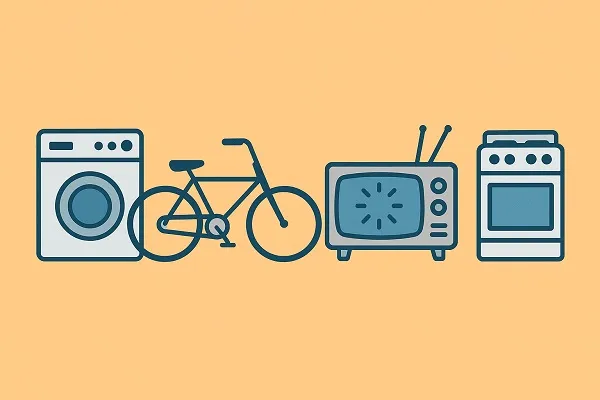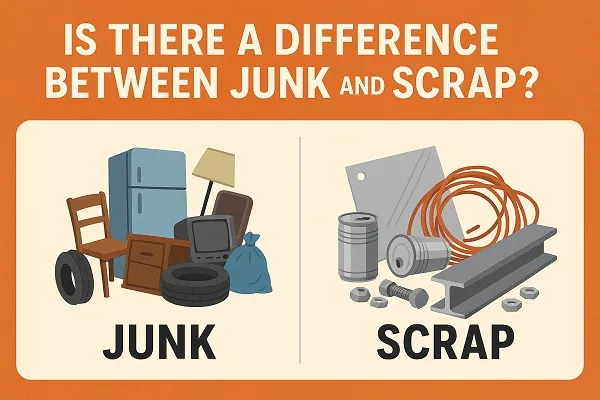Is there a difference between junk and scrap? The short answer is yes—while both terms describe items that are no longer in use, they have different meanings in recycling, waste management, and resale value. Understanding the distinction can help you decide how to dispose of materials, recover value, and reduce waste in a more sustainable way.
The terms are often used interchangeably in casual conversation, but in industries like metal recycling, construction, and automotive repair, the difference is significant. Junk is generally considered waste with little to no resale value, while scrap often refers to recyclable materials that still hold worth in raw form.
Let’s break down the definitions, examples, and practical uses of each.
What Is Junk?
Junk refers to unwanted items that have no practical use or significant resale value in their current condition. These are materials or objects you simply want to get rid of because they are broken, outdated, or useless.
Common examples include:
- Broken furniture
- Old household appliances that cannot be repaired
- Non-working electronics
- Worn-out tires
- Damaged plastic items
Junk is usually destined for landfills or waste disposal facilities unless parts can be salvaged for recycling. In many cases, junk removal companies handle the transportation and disposal of these items, sometimes separating recyclable elements before final disposal.
What Is Scrap?
Scrap refers to discarded materials—especially metals—that still have monetary value because they can be recycled and repurposed. Unlike junk, scrap is viewed as a resource rather than pure waste.
Scrap materials are typically sorted, processed, and sold to recycling centers or smelters. The value of scrap depends on the type, weight, and current market price of the material.
Examples of scrap include:
- Aluminum cans
- Copper wiring
- Steel beams
- Brass plumbing fixtures
- Car parts containing valuable metals
Even if the item is no longer functional (like a broken refrigerator), the metal components can still be sold as scrap.
Key Differences Between Junk and Scrap

1. Value
- Junk: Usually has no resale or recycling value in its current form.
- Scrap: Has measurable value due to its recyclable materials.
2. End Destination
- Junk: Often goes to landfills or waste management facilities.
- Scrap: Typically goes to recycling centers for processing.
3. Processing
- Junk: May require sorting to separate recyclable elements.
- Scrap: Is already considered a recyclable commodity.
Why the Difference Matters
Understanding whether an item is junk or scrap can influence how you handle disposal and recycling.
- Environmental Impact: Scrap recycling reduces landfill waste and conserves natural resources.
- Economic Benefit: Selling scrap can generate income, while disposing of junk often costs money.
- Compliance: Some areas have regulations on how scrap and junk must be processed to prevent environmental harm.
By identifying scrap correctly, you can contribute to both environmental sustainability and potential personal profit.
How to Identify Scrap vs. Junk
Sometimes, the difference isn’t obvious at first glance. Here are some tips for determining if something is scrap or junk:
- Check the Material – If the item contains significant amounts of metal like copper, aluminum, or steel, it may be scrap.
- Test the Condition – Items beyond repair that also lack valuable materials are likely junk.
- Look at Market Value – Research current scrap prices to see if the material is worth selling.
- Consult a Recycling Center – Professionals can assess whether your item has scrap value.
Common Misconceptions
“All old items are junk.”
Not true—many outdated products contain valuable materials. An old, broken air conditioner may be useless as a cooling device, but its copper coils are valuable scrap.
“Scrap only means metal.”
While metal is the most common scrap material, other materials—like certain plastics and paper—are also recyclable and have market value in bulk.
“Scrap and junk are disposed of the same way.”
The disposal processes differ significantly. Scrap is separated, sorted, and sold, while junk is usually discarded unless salvageable parts can be recovered.
Examples of Junk That Can Contain Scrap

Some items may appear to be pure junk but can yield valuable scrap when dismantled:
- Old Cars: Even if non-functional, the body panels, engine parts, and wiring may have scrap value.
- Broken Appliances: Washing machines, ovens, and microwaves often contain steel, copper, and aluminum.
- Electronics: Circuit boards, connectors, and wiring contain precious metals like gold and silver in small amounts.
In these cases, separating the scrap from the junk can make disposal more profitable and environmentally friendly.
Best Practices for Handling Junk and Scrap
- Sort Materials Early: Keep metals separate from general waste to avoid contamination.
- Use Proper Storage: Store scrap metals in dry areas to prevent rust, which can reduce value.
- Work with Licensed Dealers: Selling scrap to reputable recycling centers ensures fair pricing and legal compliance.
- Dispose of Junk Responsibly: Use certified waste management services to handle non-recyclable materials safely.
- Consider Upcycling: Some “junk” can be repurposed into furniture, art, or other useful items instead of being discarded.
Turning Waste Into Value
Knowing the difference between junk and scrap helps you make better decisions for your wallet and the planet. While junk often costs money to remove, scrap can generate income and support recycling efforts. The next time you’re cleaning out a garage, tearing down an old shed, or replacing appliances, take a moment to sort through your materials—you might be surprised by what you can reclaim.
Content reviewed and published by Sell My Car Colorado Editorial Team.
